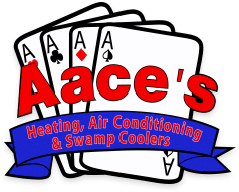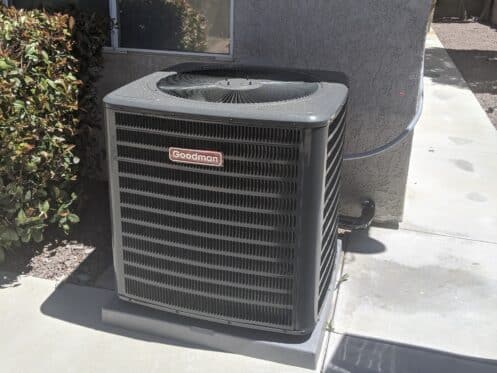Swamp coolers, also known as evaporative coolers, and central air conditioning (AC) systems share a common purpose. They both cool spaces but operate on different principles and have distinct mechanisms. Here are the key differences between swamp coolers and central AC systems.
Functionality
Swamp coolers rely on natural evaporation to cool the air. They typically comprise a fan, a water reservoir, and a series of pads or filters. When hot air is drawn into a swamp cooler, it first passes through the wet pads. As the air moves through the pads, water evaporates, causing the temperature of the air to drop. The cooler air is then circulated back into the living space, creating a refreshing effect. This process is effective in dry climates where humidity is typically low, as evaporative cooling works best in arid conditions.
On the other hand, central AC systems utilize refrigeration principles to cool the air. They consist of a compressor, a condenser, an evaporator coil, and a network of ducts that distribute cooled air throughout a building. The compressor pressurizes the refrigerant gas, which then circulates through the system. As the refrigerant passes through the evaporator coil, it absorbs heat from the indoor air, effectively cooling it. The cooled air is then blown back into the rooms through the ductwork. Afterward, the heat absorbed by the refrigerant is released to the outside air by the condenser unit, completing the cooling cycle.
Energy Consumption
While central AC systems offer precise temperature control, which makes them more effective in hotter climates, they consume more energy than swamp coolers due to their energy-intensive refrigeration process. Swamp coolers are known to use up to 75% less electricity than traditional central AC systems. This can translate to substantial cost savings on your utility bills, especially during the hot summer months when cooling needs are high.
However, it’s important to note that the energy efficiency of swamp coolers is highly dependent on the outdoor climate. These systems perform best in arid regions where the air is less humid. In more humid climates, swamp coolers may struggle to effectively cool the air, resulting in higher energy consumption as they work harder to achieve the desired temperature level. In such cases, central AC systems may be the more suitable choice.
Installation and Maintenance
Swamp coolers are generally easier and less expensive to install compared to central AC systems. Swamp coolers rely on a simple design that combines a fan, a water reservoir, and evaporative pads. The installation process typically involves mounting the unit on the roof or wall, connecting it to a water source, and ensuring proper ventilation. They also have simpler and more accessible components, making regular maintenance tasks easier to perform.
However, they require frequent cleaning or replacement of the evaporative pads, regular inspection to ensure proper water flow, and periodic cleaning of the interior to prevent mineral buildup. Additionally, since swamp coolers rely on evaporative cooling, they require regular water supply and maintenance of the water source to prevent contamination.
On the other hand, central AC systems are more complex to install since a network of ductwork has to be set up throughout the house. This involves installing an outdoor condenser unit or an indoor air handler or furnace and connecting them with ducts that distribute cooled air to various rooms. The installation process is typically more complex and broader and requires highly skilled expertise in ductwork design and installation.
Also, these systems require more extensive maintenance procedures. This typically comprises regular filter replacements, frequent cleaning of air vents and ducts, regular inspection of refrigerant levels, and occasional servicing of the outdoor condenser unit. Due to the complexity of these tasks and the involvement of refrigerant handling, it is best to seek professional help. You can rely on our HVAC technicians to provide expert installation, maintenance, and repair services.
Cooling Power
Swamp coolers excel in arid climates because they add moisture to the air, which can be beneficial for individuals suffering from dry skin or respiratory issues. However, in areas with high humidity, swamp coolers may not be as effective since they rely on the evaporation of moisture to generate cool air, and humid air already holds significant moisture content.
Conversely, central AC systems are well-suited for humid environments. Since they rely on refrigeration, they can effectively remove moisture from the air, resulting in lower humidity levels and enhanced comfort. They are also able to consistently maintain the desired temperature level regardless of external conditions, offering reliable cooling performance in various climates. Additionally, central AC systems often come with advanced features like programmable thermostats, zone control, and air filtration, allowing for precise temperature control and improved indoor air quality. These features are not typically found in swamp coolers.
Environmental Impact
Swamp coolers operate on a simple principle of water evaporation, which translates to minimal electricity consumption compared to central AC systems, making them inherently more energy efficient. Lower energy consumption means reduced carbon emissions, making swamp coolers a greener option. Central AC systems primarily rely on refrigerants like hydrochlorofluorocarbons (HCFCs) and hydrofluorocarbons (HFCs) to provide cooling. These refrigerants contribute to ozone depletion and global warming.
Noise Level
Swamp coolers use a simple mechanism that involves a fan and a water-soaked pad to cool the air. This process creates a gentle, natural breeze, resulting in minimal noise production. In contrast, central AC systems consist of multiple components, including a compressor, condenser, and fan, which typically generate more noise during operation. Although modern central AC systems are designed to be quieter than older models, they still tend to produce more noticeable noise compared to swamp coolers.
Air Quality
The evaporative cooling process in swamp coolers helps increase humidity levels, reducing the risk of dry skin or irritated respiratory passages. However, the addition of moisture can also create an environment that promotes the growth of mold and mildew, especially if the system is not regularly and properly maintained. Regular cleaning and maintenance of the swamp cooler’s water pads are necessary to prevent mold growth.
In contrast, central AC systems operate by removing heat and humidity from the indoor environment, resulting in drier air. This can be advantageous in humid climates since it helps prevent issues like mold growth and paint peeling on walls. Additionally, these systems often come with built-in air filters that help improve indoor air quality by trapping dust, pollen, and other allergens. However, you should note that these filters require regular cleaning and replacement to ensure optimal performance.
Call the Professionals
When it comes to expert guidance and comprehensive services for all your cooling needs, Aace's Heating, Air Conditioning & Swamp Coolers stands out! Not only do we specialize in the installation and maintenance of swamp coolers and central AC systems in Victorville, but we also offer a range of HVAC services to ensure that you experience optimal indoor comfort year-round. From heating solutions and air quality assessments to duct cleaning and thermostat installations, we provide a holistic approach to HVAC systems.
Our skilled professionals have extensive HVAC knowledge and experience, so you can trust us to provide top-notch service and personalized solutions tailored to your specific HVAC requirements.
Contact Aace's Heating, Air Conditioning & Swamp Coolers today to experience the difference in quality service and expertise.
Services We Offer include:






